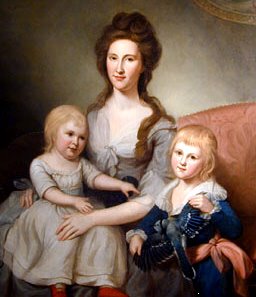- What role did the Revolutionary War play in the transformation if housewifery to Republican Motherhood?
2. What were the consequences of Republican Motherhood on women?
Women were educated more frequently and thoroughly after Republican Motherhood because they were expected to pass down this knowledge to their children. They also became more respected members of society, because they had gained the job of educating the next generation.
3. What is the significance of the ideology of Republican Motherhood as a stage in the process of women's socialization?
While women were not completely introduced to public work or value, they were given more meaning because their work in the home became of more importance. Women began to be respected because they could influence coming generations, and their education.
Mary Gibson Tilghman and her sons by Charles Willson Peale (1789)

1. Setting
Mary and her sons are painted on an ornate sofa while dressed in respectful clothes, yet the boys are attempting to play with each other, contradicting the otherwise sophisticated painting.
2. Who's the center? Why? How does the woman look? How is she "Republican" rather than aristocratic?
Mary Gibson Tilghman is the center of the painting, as shown by the lighting. This is because of her importance and center in the home life. She appears to be separating her playing children, yet still remaining composed and focused on the painting. She appears Republican because she does not wear jewelry or fancy clothes that one would connect to the extravagance of aristocratic paintings.
3. What values do her sons exhibit?
Her sons appear to be well dressed, and well put together. However, you can see them trying to play with each other showing a glimpse of real house life at the time. Yet while they are restless the mom handles it well and prepares them for the painting.
4. Is there a significance to the positioning of her arm?
You can see how she is keeping her younger son in place as he is restless during the painting time. This shows how she has control over her children, and will mold them throughout their lives as a mothering authority figure.
Republican Motherhood still present today, however altered

Comments
Post a Comment